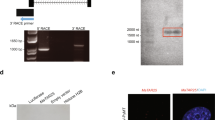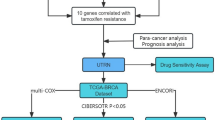Abstract
Personalized medicine requires the identification of unambiguous prognostic and predictive biomarkers to inform therapeutic decisions. Within this context, the management of lymph node-negative breast cancer is the subject of much debate with particular emphasis on the requirement for adjuvant chemotherapy. The identification of prognostic and predictive biomarkers in this group of patients is crucial. Here, we demonstrate by tissue microarray and automated image analysis that the cocaine- and amphetamine-regulated transcript (CART) is expressed in primary and metastatic breast cancer and is an independent poor prognostic factor in estrogen receptor (ER)-positive, lymph node-negative tumors in two separate breast cancer cohorts (n=690; P=0.002, 0.013). We also show that CART increases the transcriptional activity of ERα in a ligand-independent manner via the mitogen-activated protein kinase pathway and that CART stimulates an autocrine/paracrine loop within tumor cells to amplify the CART signal. Additionally, we demonstrate that CART expression in ER-positive breast cancer cell lines protects against tamoxifen-mediated cell death and that high CART expression predicts disease outcome in tamoxifen-treated patients in vivo in three independent breast cancer cohorts. We believe that CART profiling will help facilitate stratification of lymph node-negative breast cancer patients into high- and low-risk categories and allow for the personalization of therapy.
This is a preview of subscription content, access via your institution
Access options
Subscribe to this journal
Receive 50 print issues and online access
$259.00 per year
only $5.18 per issue
Buy this article
- Purchase on Springer Link
- Instant access to full article PDF
Prices may be subject to local taxes which are calculated during checkout





Similar content being viewed by others
Accession codes
References
Adriaenssens E, Vanhecke E, Saule P, Mougel A, Page A, Romon R et al. (2008). Nerve growth factor is a potential therapeutic target in breast cancer. Cancer Res 68: 346–351.
Arora S, Anubhuti . (2006). Role of neuropeptides in appetite regulation and obesity–a review. Neuropeptides 40: 375–401.
Bech P, Winstanley V, Murphy KG, Sam AH, Meeran K, Ghatei MA et al. (2008). Elevated cocaine- and amphetamine-regulated transcript immunoreactivity in the circulation of patients with neuroendocrine malignancy. J Clin Endocrinol Metab 93: 1246–1253.
Borgquist S, Jogi A, Ponten F, Ryden L, Brennan DJ, Jirstrom K . (2008). Prognostic impact of tumour-specific HMG-CoA reductase expression in primary breast cancer. Breast Cancer Res 10: R79.
Brennan D, Jirstrom K, Kronblad A, Millikan R, Landberg G, Duffy M et al. (2006). CA IX is an independent prognostic marker in premenopausal breast cancer patients with one to three positive lymph nodes and a putative marker of radiation resistance. Clin Cancer Res 12: 6421–6431.
Brennan DJ, O'Connor DP, Rexhepaj E, Ponten F, Gallagher WM . (2010). Antibody-based proteomics: fast-tracking molecular diagnostics in oncology. Nat Rev Cancer 10: 605–617.
Brennan DJ, Rexhepaj E, O' Brien SL, Mc Sherry E, O'Connor DP, Fagan A et al. (2008). Altered cytoplasmic-nuclear ratio of survivin is a prognostic indicator in breast cancer. Clin Cancer Res 14: 2681–2689.
Cardoso F, Van't Veer L, Rutgers E, Loi S, Mook S, Piccart-Gebhart MJ . (2008). Clinical application of the 70-gene profile: the MINDACT trial. J Clin Oncol 26: 729–735.
Chang C, Norris JD, Gron H, Paige LA, Hamilton PT, Kenan DJ et al. (1999). Dissection of the LXXLL nuclear receptor-coactivator interaction motif using combinatorial peptide libraries: discovery of peptide antagonists of estrogen receptors alpha and beta. Mol Cell Biol 19: 8226–8239.
Chanrion M, Negre V, Fontaine H, Salvetat N, Bibeau F, Mac Grogan G et al. (2008). A gene expression signature that can predict the recurrence of tamoxifen-treated primary breast cancer. Clin Cancer Res 14: 1744–1752.
Cheng J, Zhang C, Shapiro DJ . (2007). A functional serine 118 phosphorylation site in estrogen receptor-alpha is required for down-regulation of gene expression by 17beta-estradiol and 4-hydroxytamoxifen. Endocrinology 148: 4634–4641.
Dolle L, Adriaenssens E, El Yazidi-Belkoura I, Le Bourhis X, Nurcombe V, Hondermarck H . (2004). Nerve growth factor receptors and signaling in breast cancer. Curr Cancer Drug Targets 4: 463–470.
Dominguez G . (2006). The CART gene: structure and regulation. Peptides 27: 1913–1918.
Dominguez G, Kuhar M . (2004). Transcriptional regulation of the CART promoter in CATH a cells. Brain Res Mol Brain Res 126: 22–29.
Douglass J, McKinzie AA, Couceyro P . (1995). PCR differential display identifies a rat brain mRNA that is transcriptionally regulated by cocaine and amphetamine. J Neurosci 15: 2471–2481.
EBCTCG (1998). Tamoxifen for early breast cancer: an overview of the randomised trials. Early Breast Cancer Trialists’ Collaborative Group. Lancet 351: 1451–1467.
EBCTCG (2005). Effects of chemotherapy and hormonal therapy for early breast cancer on recurrence and 15-year survival: an overview of the randomised trials. Lancet 365: 1687–1717.
Elefteriou F, Ahn J, Takeda S, Starbuck M, Yang X, Liu X et al. (2005). Leptin regulation of bone resorption by the sympathetic nervous system and CART. Nature 434: 514–520.
Epping MT, Wang L, Plumb JA, Lieb M, Gronemeyer H, Brown R et al. (2007). A functional genetic screen identifies retinoic acid signaling as a target of histone deacetylase inhibitors. Proc Natl Acad Sci USA 104: 17777–17782.
Goldhirsch A, Glick J, Gelber R, Coates A, Thürlimann B, Senn H et al. (2005). Meeting highlights: international expert consensus on the primary therapy of early breast cancer 2005. Ann Oncol 16: 1569–1583.
Howell A, Cuzick J, Baum M, Buzdar A, Dowsett M, Forbes JF et al. (2005). Results of the ATAC (Arimidex, Tamoxifen, Alone or in Combination) trial after completion of 5 years′ adjuvant treatment for breast cancer. Lancet 365: 60–62.
Jia J, Chen X, Zhu W, Luo Y, Hua Z, Xu Y . (2008). CART protects brain from damage through ERK activation in ischemic stroke. Neuropeptides 42: 653–661.
Kato S, Endoh H, Masuhiro Y, Kitamoto T, Uchiyama S, Sasaki H et al. (1995). Activation of the estrogen receptor through phosphorylation by mitogen-activated protein kinase. Science 270: 1491–1494.
Keegan BP, Akerman BL, Pequeux C, North WG . (2006). Provasopressin expression by breast cancer cells: implications for growth and novel treatment strategies. Breast Cancer Res Treat 95: 265–277.
Koylu E, Balkan B, Kuhar M, Pogun S . (2006). Cocaine and amphetamine regulated transcript (CART) and the stress response. Peptides 27: 1956–1969.
Koylu EO, Couceyro PR, Lambert PD, Ling NC, DeSouza EB, Kuhar MJ . (1997). Immunohistochemical localization of novel CART peptides in rat hypothalamus, pituitary and adrenal gland. J Neuroendocrinol 9: 823–833.
Kristensen P, Judge M, Thim L, Ribel U, Christjansen K, Wulff B et al. (1998). Hypothalamic CART is a new anorectic peptide regulated by leptin. Nature 393: 72–76.
Lakatos A, Prinster S, Vicentic A, Hall R, Kuhar M . (2005). Cocaine- and amphetamine-regulated transcript (CART) peptide activates the extracellular signal-regulated kinase (ERK) pathway in AtT20 cells via putative G-protein coupled receptors. Neurosci Lett 384: 198–202.
Mantzoros C, Bolhke K, Moschos S, Cramer D . (1999). Leptin in relation to carcinoma in situ of the breast: a study of pre-menopausal cases and controls. Int J Cancer 80: 523–526.
O′Brien SL, Fagan A, Fox EJ, Millikan RC, Culhane AC, Brennan DJ et al. (2007). CENP-F expression is associated with poor prognosis and chromosomal instability in patients with primary breast cancer. Int J Cancer 120: 1434–1443.
Rogge G, Jones D, Hubert GW, Lin Y, Kuhar MJ . (2008). CART peptides: regulators of body weight, reward and other functions. Nat Rev Neurosci 9: 747–758.
Ruscica M, Dozio E, Motta M, Magni P . (2007). Role of neuropeptide Y and its receptors in the progression of endocrine-related cancer. Peptides 28: 426–434.
Ryden L, Jonsson P, Chebil G, Dufmats M, Ferno M, Jirstrom K et al. (2005). Two years of adjuvant tamoxifen in premenopausal patients with breast cancer: a randomised, controlled trial with long-term follow-up. Eur J Cancer 41: 256–264.
Ryden L, Linderholm B, Nielsen NH, Emdin S, Jonsson PE, Landberg G . (2003). Tumor specific VEGF-A and VEGFR2/KDR protein are co-expressed in breast cancer. Breast Cancer Res Treat 82: 147–154.
Sen A, Lv L, Bello N, Ireland JJ, Smith GW . (2008). Cocaine- and amphetamine-regulated transcript accelerates termination of follicle-stimulating hormone-induced extracellularly regulated kinase 1/2 and Akt activation by regulating the expression and degradation of specific mitogen-activated protein kinase phosphatases in bovine granulosa cells. Mol Endocrinol 22: 2655–2676.
Shang Y, Brown M . (2002). Molecular determinants for the tissue specificity of SERMs. Science 295: 2465–2468.
Taylor AH, Ang VT, Jenkins JS, Silverlight JJ, Coombes RC, Luqmani YA . (1990). Interaction of vasopressin and oxytocin with human breast carcinoma cells. Cancer Res 50: 7882–7886.
Thurlimann B, Keshaviah A, Coates AS, Mouridsen H, Mauriac L, Forbes JF et al. (2005). A comparison of letrozole and tamoxifen in postmenopausal women with early breast cancer. N Engl J Med 353: 2747–2757.
Van't Veer LJ, Dai H, van de Vijver MJ, He YD, Hart AA, Mao M et al. (2002). Gene expression profiling predicts clinical outcome of breast cancer. Nature 415: 530–536.
Yamashita H, Nishio M, Toyama T, Sugiura H, Kondo N, Kobayashi S et al. (2008). Low phosphorylation of estrogen receptor alpha (ERalpha) serine 118 and high phosphorylation of ERalpha serine 167 improve survival in ER-positive breast cancer. Endocr Relat Cancer 15: 755–763.
Zoubir M, Mathieu MC, Mazouni C, Liedtke C, Corley L, Geha S et al. (2008). Modulation of ER phosphorylation on serine 118 by endocrine therapy: a new surrogate marker for efficacy. Ann Oncol 19: 1402–1406.
Zujewski JA, Kamin L . (2008). Trial assessing individualized options for treatment for breast cancer: the TAILORx trial. Future Oncol 4: 603–610.
Zwijsen RM, Buckle RS, Hijmans EM, Loomans CJ, Bernards R . (1998). Ligand-independent recruitment of steroid receptor coactivators to estrogen receptor by cyclin D1. Genes Dev 12: 3488–3498.
Acknowledgements
The UCD Conway Institute is funded by the Program for Third Level Institutions, as administered by the Higher Education Authority of Ireland. Funding is acknowledged from the Health Research Board of Ireland, Enterprise Ireland and the Science Foundation Ireland Strategic Research Cluster award to Molecular Therapeutics for Cancer Ireland (08/SRC/B1410). The work of Dr R Zagozdzon has been supported by a Marie Curie International Reintegration Grant no. 224865 within the 7th European Community Framework Program. Dr MJ Kuhar is funded by RR00165.
Author information
Authors and Affiliations
Corresponding author
Ethics declarations
Competing interests
Drs Rexhepaj, Brennan and Gallagher are the inventors of a pending patent application in relation to the development of novel automated image analysis approaches in histopathology.
Additional information
Supplementary Information accompanies the paper on the Oncogene website
Rights and permissions
About this article
Cite this article
Brennan, D., O'Connor, D., Laursen, H. et al. The cocaine- and amphetamine-regulated transcript mediates ligand-independent activation of ERα, and is an independent prognostic factor in node-negative breast cancer. Oncogene 31, 3483–3494 (2012). https://doi.org/10.1038/onc.2011.519
Received:
Revised:
Accepted:
Published:
Issue Date:
DOI: https://doi.org/10.1038/onc.2011.519
Keywords
This article is cited by
-
Energy homeostasis genes modify the association between serum concentrations of IGF-1 and IGFBP-3 and breast cancer risk
Scientific Reports (2022)
-
Structural-Functional Organization of Cart Peptide-Expressing Neurons in the Amygdaloid Body of the Brain
Neuroscience and Behavioral Physiology (2015)



